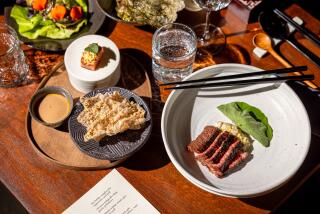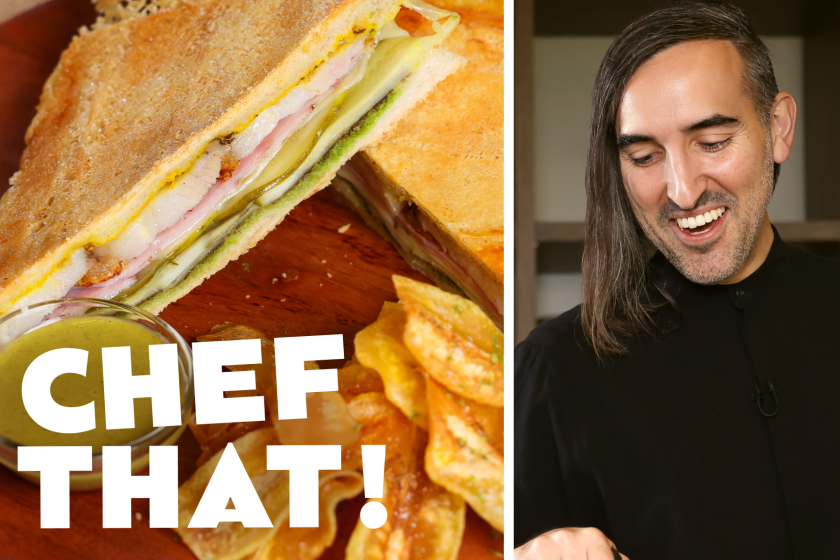Cellar Rats : Knee-Deep in the Crush of the Phelps Winery Harvest
Clusters of Sauvignon blanc--the grapes small and tightly packed against each other, with a few leaves still bound to the stems--spill from the gondola into the long crusher-stemmer bin. At daybreak theyâd hung heavy on the symmetrical row of twisted vines that stretch across the Joseph Phelps Vineyards home ranch in the Napa Valleyâs eastern hills. Half an hour later, 10 pickers had begun to strip the vines. Largely hidden by the leafy, six-foot-high canopy, they had sliced through tender stems with small, sickle-shaped knives, wrestled with fibrous stalks and heaved tub after tub of green berries and sweet, yellow juice into the gondola one row over.
In the wineryâs cellar, a quarter-mile up a rounded hill, the air is laced with the sharp smell of yeast and vinegar. Thick hoses, carrying water or wine, snake past the sets of stainless-steel fermentation tanks--which have capacities ranging from 1,500 to 6,000 gallons--and connect to other tanks, pumps and presses. To the left of the big cellar door, a two-inch column of water is streaming out of a tank and onto the floor. When veteran cellar-hand and bottling supervisor Damian Parker unlatches the tankâs hatch, the remaining water gushes out and flows toward the drain grates that run the length of each row of the cylindrical tanks.
âGoing in here with the Sauvignon blanc,â Parker shouts. He leans into the tankâs opening to check it by flashlight, lays out the wine hose and sets the temperature gauge to 55 degrees, to cool the air inside.
Ten feet away, a pump sucks up red juice from the bottom of a 3,000-gallon tank and pushes it through a hose back to the top of the tank, where Vicki Murray, one of the cellar workers--or cellar rats, as they call themselves--sits 20 feet off the ground, her legs straddling the opening. As the red juice sprays out over the foamy cap of skins that have risen to the top, she slowly swings the hose back and forth, much as an elephant might if it had hands to help move its trunk. When sheâs done, she flushes out the hose.
âWatch out below,â she cries as grape skins, juice and water spurt onto the floor.
Outside, a flatbed hauling five bins of Sangiacomo Chardonnay grapes pulls up. Its contents are quickly weighed and tipped into the crusher-stemmer.
In the press house, the crushed Sauvignon blanc grapes and juice are pulsing through a clear, ribbed hose and into the opening of the Willmes Presser, which extracts the juice from the pulp. Paul Steinhauer, a college student whose academic career is about to resume after a year and a half at Phelps, empties into the press what remains in a 50-pound sack of rice hulls and shuts the hatch.
âWe add these to âslime ballâ grapes,â he explains, starting to hose the area clean. âIt keeps the screens from clogging, keeps the juice channels open and fluffs it up.â
Close by, Zinfandel is being transferred from press No. 2 to a holding tank. Assistant wine maker Gary Brookman looks on as cellar worker Jeff Virnig crouches low, his hand on the hose to feel the hot water that is pushing the last of the red wine through. âHere it comes,â Brookman yells.
Behind them, two others--one at each end of the hose that links their two tanks--coordinate efforts while topping a tank. âFive,â cries one. âFive,â the other calls back. âFourâ . . . âfour.â âThreeâ . . . âthree.â The shouts echo through the cellar. âTwoâ . . . âtwo.â âOneâ . . . âcut!â yells the worker at the top of the tank being filled, and the valves are shut tight.
Above them, lanky Michael DuBois hoses down a 6,000-gallon tank and begins to soap the top. âOne-half of all wine making is cleaning,â announces Eric Neil in passing. Suddenly a loud noise--a slap-bang that doesnât belong--silences the cellar rats.
âEveryone OK?â someone shouts. When the question remains unanswered, two of them break into a half-run. They yell again as they round the corner to the next set of tanks, heads tilted upward, in the direction of the noise. Only when DuBois reappears, unhurt, do they relax.
Two hours later, DuBois is wedged between a wall and a seeping oak barrel. He finds the pin-sized leak, works a wood plug out of his pocket, whittles it down to the size of a stubby toothpick and pounds it into the hole. On his way out of the barrel room, he grabs a taste of the new Zinfandel that has just been transferred into barrels. âNot bad,â he pronounces.
At 6 p.m. the work stops for an hour. Completely. The dinners Phelps provides Monday through Thursday during the harvest season are not your average shift meals; employees are welcome to invite mates and children, and the fare is gourmet. Ceviche . Bouillabaisse. Scotch broth. Poached salmon a la maltaise.
While chef Michelle Mutrux sets the appetizer of aioli , a garlic-mayonnaise spread, on the table, wine maker Craig Williams pours a â78 Phelps Chardonnay, then cracks a fifth of â83 Meursault and passes that as well. The merits of each are analyzed as the 13 diners sniff, pucker and taste. Wine--and beer, too--continues to flow through dinner. Espresso is served with the Lemon Bavarian and raspberry-puree dessert.
By 7, the late shift is back at work.
More to Read
Eat your way across L.A.
Get our weekly Tasting Notes newsletter for reviews, news and more.
You may occasionally receive promotional content from the Los Angeles Times.










